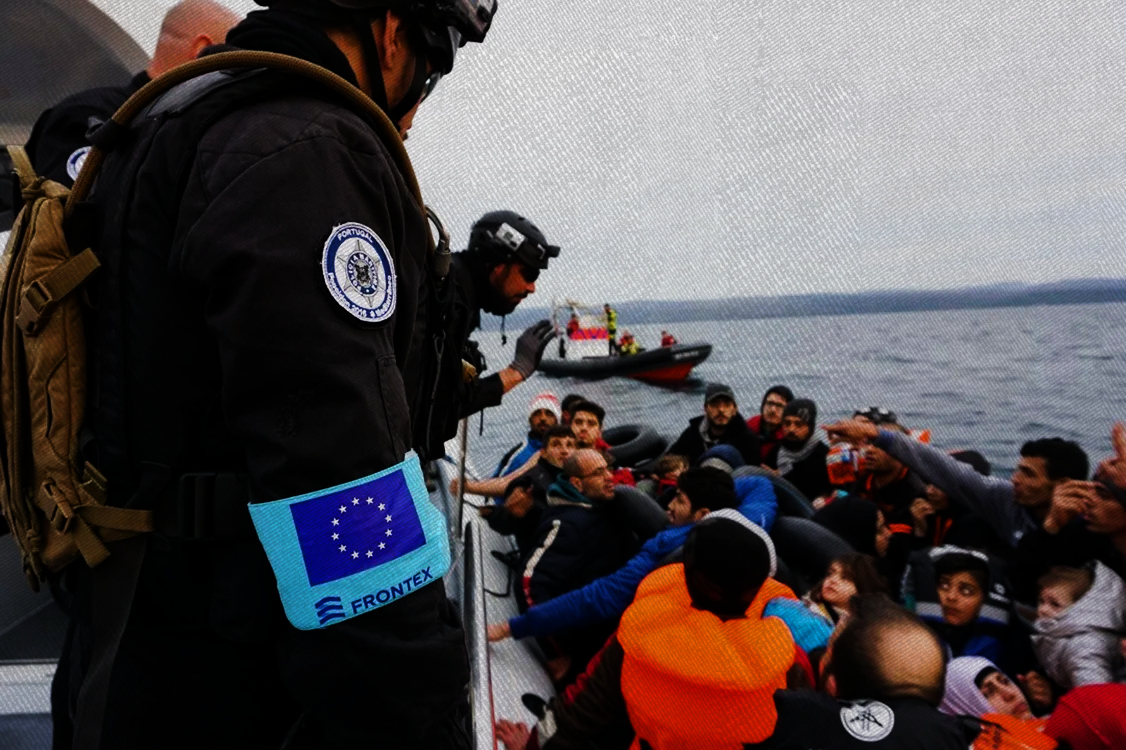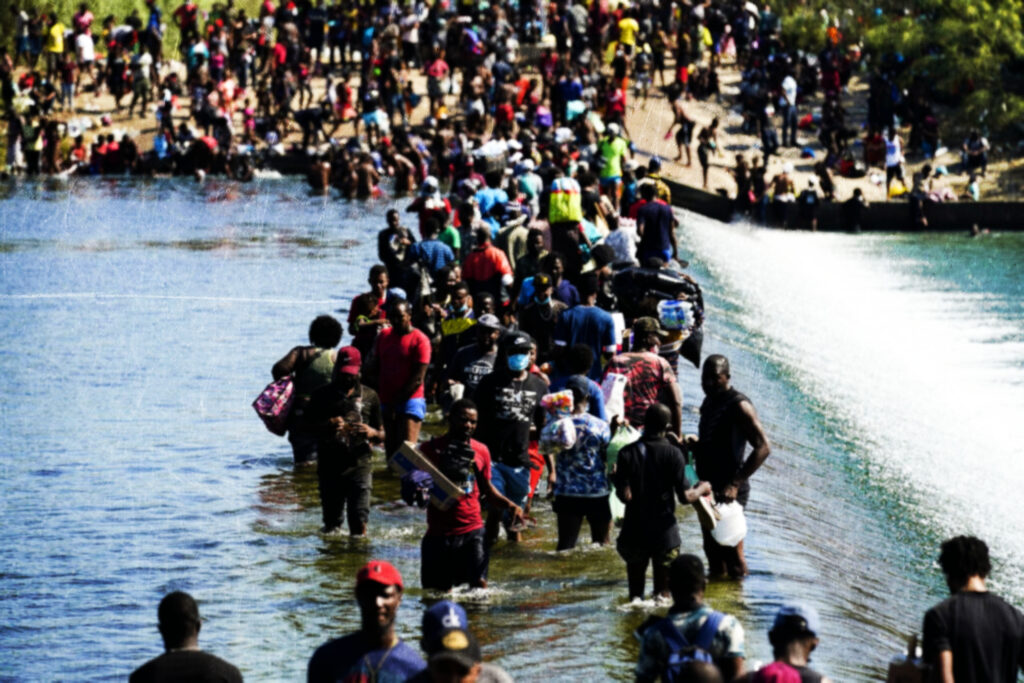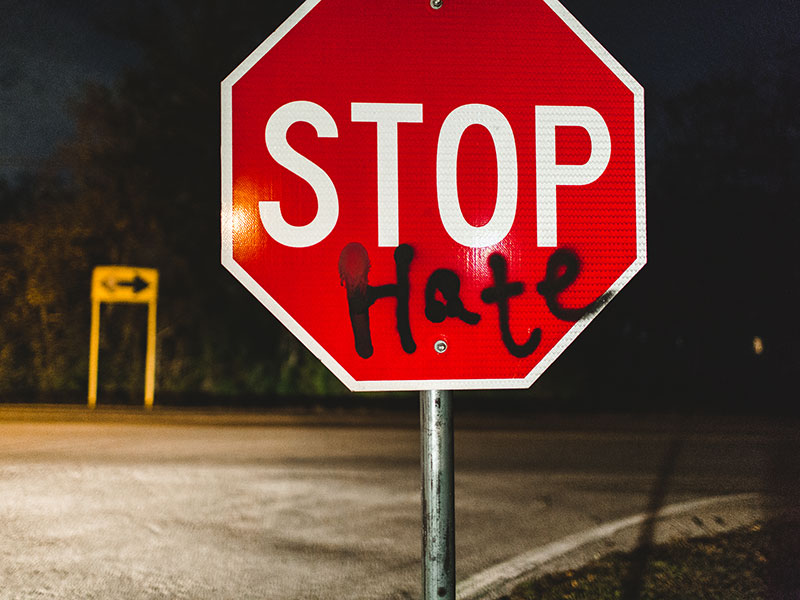Everywhere in Europe racism creeps with increasing ease due to the voices of the xenophobic formations and the ultra-conservative stands. But also through a system of borders and policies that reveal an increasing institucionalization of said xenophobia.
When in 2012 the European Commission launched a spot with xenophobic content that capitalized on the fear of others1 it received a lot of criticism. But was that spot an isolated event or a demonstration that the pillars of the European project are supported in part by racism and the rejection of immigration?
The migratory context in the world and in Europe
When immigration is treated as a “problem”, something very common in the neoliberal speech shared by the European Union, it is to make us imagine a horde of invaders that hit the walls of our fortress-continent, whose supposed objective would be to completely collapse our civilization and take advantage of the “welfare state.” But, are these immigrants really as many as they try to make us believe?
Total immigration in the world represents about 1 billion people. Most of this is internal, that is, within the same country. Only 20% would be international migration, which, according to the latest data, is 280.6 million people2, approximately 3.6% of the world population. This percentage has undergone a slight increase: it constituted 3.5% in 2019, 2.8% in 2000 and 2.3% in 19803. Contrary to common reasoning, 60% of migrations occur between impoverished countries or between enriched countries, and only a third would migrate from impoverished countries to enriched countries.
Therefore, in front of the image of the “invading horde”, it is necessary to contrast another, more real one: immigration from poor countries represents the smallest part of migratory flows, far from being the global reality of which they want to convince us.
Another classification usually presented is that of “forced” or “voluntary” migration. “Forced” migration is understood as that which is due to armed conflicts, violent persecution or climatic disasters, while “voluntary” refers to anyone that does not respond to these causes and is generally known as “economic migration”. All of this is enclosed in quotation marks because, as we will see later, reasons as “voluntary” as hunger or the lack of schools can be a form of forced migration or, in other words, fleeing from these realities is far from being voluntary.
In any case, if we understand as forced displacement all migration due to conflicts or disasters, it has grown from about 40 million in 2011 to almost 70 million in 20204, almost 0.9% of the world population, which shows the existence of an increasingly conflictive world, inherent to an accelerated capitalism addicted to robbery.
Let’s take a look to the specific case that concerns us with Europe. The famous “Europe’s migration crisis” of 2015 has been deflating in the medium term (from the 1.8 million people seeking to cross the EU borders in 2015, they have gone to as few as 204,219 in 20175), but it will still continue to shape a big part of the political speeches in electoral and legislative processes. The way in which this crisis, due to conflicts such as those in Syria or Afghanistan, has been managed reveals one more of the failures of the European project. Faced with a humanitarian problem of these characteristics, the solution has been, as David Cameron said in 2015, “more fencing, more resources, more sniffer dog teams, more assistance”6. It happens that conceiving immigration as an invasion or an avalanche only grants two possible responses: reject and repel or assist as in an emergency. It thus becomes a “problem” that must be got rid of as soon as possible, a commodity that must be relocated, and not people with a voice and to whom it is necessary to listen. This dehumanizing approach is not accidental, as detailed in this same text.
Legal refugees and illegal immigrants
The causes of this approach by the European Union are partly ideological, and could be based on the text of the Geneva 1951 Convention Relating to the Status of Refugees, which defines the refugee as someone who:
owing to well-founded fear of being persecuted for reasons of race, religion, nationality, membership of a particular social group or political opinion, is outside the country of his nationality and is unable or, owing to such fear, is unwilling to avail himself of the protection of that country; or who, not having a nationality and being outside the country of his former habitual residence as a result of such events, is unable or, owing to such fear, is unwilling to return to it.7
This logic, repeated during the 2015 refugee crisis, is that all those fleeing armed conflicts should be welcomed in accordance with international law. But, what about those people whose situation does not conform to this legal framework? Would barbed wire, immigrant internment centers and trained dogs be justifiable?
Indeed, the speech on immigration in the EU has increasingly excluded, and in the most drastic way, those who do not fall within the narrow definition of “refugee.”
Are economic migrations really voluntary? What happens when misery, hunger or desertification endanger human lives? Those fleeing from lack of food are not looking to “improve their future prospects”, but to survive. It is necessary to change the logic that governs the conception of a refugee as that of someone persecuted, for that of someone fleeing. And from hunger and misery you can also flee.
A case that illustrates this reality well would be the fact that international legislation does not protect the more than 200 million people who, according to the International Committee of the Red Cross8, are displaced directly or indirectly due to causes related to climate change and environmental degradation.
History of migration policy in the EU
The Schengen Agreement, signed in 1985 and which entered into force in 19959, established a common space (called the Schengen Area) through which all those who reside in one of the countries that have signed the agreement can move freely. It abolished internal border controls by moving them to external borders.
In other words, as a condition for free internal movement, it was necessary to shield the exterior, building a “Fortress Europe”. Included in the Treaty of Amsterdam of 199710 there is a whole battery of measures designed to guarantee the solidity of its walls:
- The Schengen border code, which governs all casuistry relating to the crossing of external borders.
- As not all countries have the same “burden” of external borders to protect, the EU dedicates a part of its funds to offsetting part of the costs that these entail for bordering states.
- Centralized databases were created in order to manage borders and migrations: The Schengen Information System (SIS)11, the Visa Information System(VIS)12 and Eurodac13, the European fingerprint database.
- Measures designed to prevent and sanction the entry and movement of irregular immigrants known as “border crossers” are established.
- And an agency is set up for direct cooperation on the borders of the different states, the European Agency for the Management of Operational Cooperation at the External Borders of the Member States of the European Union, better known as Frontex.
Frontex has been gaining a lot of weight in this “shielding of the borders” of which we spoke earlier. The agency, based in Warsaw, has among its functions air, maritime and land surveillance operations, the administration of the European external border surveillance system, Eurosur14 (European Border Surveillance System), which allows sharing the entire system of radar, satellites and drones for surveillance and detection among EU member states, as well as the “risk analyzes” that try to identify the most used routes of entry into Europe.
The agency has authorization to supervise the actions of the border police of the member states, but in practice it intervenes directly, even without the approval of the affected country itself, which constitutes an undermining of the sovereignty of the member states .
The objective sought is for Frontex to become the new European Border and Coast Guard, with a power that is even above the sovereignty of the member states in everything related to the protection of the Schengen area.
In 2013 another important milestone was reached: a convention aimed at rationalizing and harmonizing the asylum legislation currently in force in the EU, known as Dublin III or Regulation (EU) No. 604/201315. It is assumed that the objective is to prevent a refugee from seeking asylum in several member states simultaneously and at the same time ensure that there is at least one where he can do so.
The most controversial aspect of this new regulation, and that is behind a large part of the problems that asylum seekers currently face, is the obligation to present such application in the first EU country they access, no matter what language difficulty or lack of cultural affinity with the state there is. The goal is to turn southern Europe into “buffer states” to prevent the migratory flow towards the northern countries: yet another piece of the “Fortress Europe”. However, as it was seen in 2015, this could be counterproductive, as the southern countries overflow with the massive arrival of refugees.
In 2016 came another interesting “innovation” in the fortification of the Schengen area: the agreement between the EU and Turkey of 201616, or externalization of borders. By agreeing to become Europe’s “border gendarmes”, countries like Turkey improve their diplomatic and trade relations with the EU and receive a substantial “development” aid. And Europe thus externalizes the images of persecution of immigrants and brutality, who remain on the other side of the border.
The word “innovation” is also enclosed in quotation marks because one of the pioneers in the externalization of borders has been the Spanish state with the Moroccan border. And the recent escalation of tension with Morocco, over the reception in Spain of the leader of the Polisario Front, has revealed on the beaches of Ceuta not only the images that Europe tries to avoid using external countries as “gendarme”, but to what extent human beings can be used as weapons in a diplomatic conflict17.
Building the fear of the other
The terrible 9/11 attacks ushered in a new era throughout the world. Neoliberalism, which had announced “the end of history” with Francis Fukuyama after the fall of the Berlin Wall18, needed new enemies after the defeat of communism. And urgently, since the generalized austerity measures and the loss of sovereignty in the face of a dictatorship of capital in an increasingly globalized world made it necessary for a new external threat to justify the “protection” of the governments of enriched countries such as those of Europe. That is why the “shock” resulting from the fall of the twin towers would have been seen by some as an opportunity: to build the antagonist in the new era. Thus, in 2001, Islamophobia and the “war against terrorism” appeared.
Islamophobia, which presents the Islamic world in the popular imagination as a formless and barbaric chaos, capable of the greatest atrocities, has served and serves not only as a lever for the xenophobic discourses of the far-right formations on the rise in Europe, but also to promote the rejection of immigration from the same institutions.
A representative case is that of the President of the Czech Republic, Milos Zerman, when in 2015 he assured that the wave of refugees was “an organized invasion”19. The Spanish Interior Minister Jorge Fernández Díaz also affirmed that the extremism and terrorism of DAESH “is a cancer that has spread throughout the Middle East and that it is necessary to extirpate”20, and suggested that among the refugees from Syria there could be infiltrators from DAESH.
The Paris attacks of November 201521 awoke in the public imagination the fear of everything foreign (and of everything Islamic mainly), and were used as another stone in the fortification of Europe. The “war against terrorism” normalized legal exceptions, such as those of the “Anti-Terrorism, Crime and Security Act” of 2001 in England22, which allowed the indiscriminate detention without trial of foreigners until they were challenged, resulting in the stigmatization of irregular migration equating it to a threat to national security.
Along with the fear of the Islamic world comes the criminalization of poverty. The increase in immigration is linked by certain media to that of crime, using certain isolated cases (“cherry picking”23) and magnifying them to make them look like an emergency situation.
This is the case of the campaign of the Spanish party Ciudadanos in 2018, where an episode of aggression against a North American tourist was used to make the population believe that the street vendors were an organized and dangerous criminal group24, or like the speeches of Jean-Marie Le Pen on immigration in France that managed to turn the entire political arc with their demagogic messages, promoting a climate of competition to offer “tough” solutions without the party even holding power. This is what is commonly known in France as “lepenisation of spirits”25.
This, together with the discourse of “first those from here” in the framework of austerity policies, has no other objective than to confront the population against itself so that it does not organize to face the true causes of its discomfort, which are large companies and financial interests. In addition there is an obvious advantage of having a part of the population stigmatized and lacking rights, who, seeing themselves defenseless and in urgent need, will work for miserable wages without enjoying the most basic protections of the welfare state.
Irregular immigration is merchandise
Can irregular immigration be business? Clearly, taking into account the figures managed by the mafias that facilitate the smuggling of migrants. In its 2010 report, the United Nations Office on Drugs and Crime (UNODC) estimated at 6.75 billion dollars26 the money generated annually by the two main routes: from East Africa to Europe and from South America to North America.
To this must be added other legal actors that have also benefited, such as the $ 350,000 that Air Berlin pocketed in 2015 for operating charter flights to deport immigrants whose asylum applications had been rejected, or such as the Temporary Union of Companies formed by Air Europa and Swiftair, which has 12 million euros per year for this same service in the Spanish state27.
Additionally, we can talk about the benefits of the prison sector: the Inmigrant Internment Centers, where all-powerful security companies like G4S28 run prisons and centers for immigrants, have horrifying stories of human rights abuses. Despite the opacity of the contracts, according to Corporate Watch, they have a profit rate of 20% on the amount of the tenders29.
The international journalism project The Migrants Files30 estimated at 11.3 billion euros what the policies of repatriation of immigrants cost European taxpayers during the period 2000-201431, while the mafias on both sides of the border earned a total of 15.7 billion doing the reverse work. Clearly, for many actors (outsourced companies and mafias), irregular immigration is a golden business, paid for with European money and human lives: according to the Spanish Commission for Refugee Aid (CEAR), during 2020, the ratio was 1.6 dead people for every 100 in the migratory transit of the Mediterranean32.
Alternatives
Faced with this increasingly fortified Europe, what are the alternatives? We live in a time in which Brexit has made disobedience to Europe taboo. However, Brexit is precisely a by-product of “Fortress Europe” and the “fear of the other”, and proof of this is that it arose in one of the countries initially most loyal to the European project, such as England.
What we propose is disobedience to the treaties: the Stability Pact, the Lisbon Treaty or Dublin III. With the aim of building bridges and tearing down walls, creating a Europe of the peoples and Human Rights, which puts the popular classes at its center and social justice as its objective.
As goals to reach this point, we must fight for the end of austerity and the budget cuts that make populations clash against each other (in Europe and in the rest of the world), pointing to immigration as a false “problem” to avoid that the true architects of our discomfort are exposed. Without the mirage of scarcity that neoliberal austerity brings, neither the speeches as “there is not enough for everyone” or “nationals first” with which the European institutions and the far-right bombard us, and that serve as a support to “Fortress Europe”, can be sustained.
This way, we will put an end to this fortified Europe and the institutionalized racism and we will take a firm step towards a Europe (and a world!) for the peoples.
1https://www.theguardian.com/world/2012/mar/06/european-commission-criticised-racist-ad 2https://www.migrationdataportal.org/es/international-data?i=stock_abs_&t=2020 3https://www.un.org/es/global-issues/migration 4https://www.migrationdataportal.org/es/themes/migracion-forzosa-o-desplazamiento-forzoso 5https://mondediplo.com/2018/11/09migration 6https://www.macleans.ca/news/world/david-cameron-commits-dogs-and-fencing-to-help-france-control-migrant-surge/ 7https://eacnur.org/es/convencion-de-ginebra-de-1951-el-estatuto-de-los-refugiados 8https://www.icrc.org/es/document/informe-cicr-cambio-climatico-y-conflictos-una-cruel-combinacion 9http://www.interior.gob.es/web/servicios-al-ciudadano/extranjeria/acuerdo-de-schengen 10https://www.europarl.europa.eu/topics/treaty/pdf/amst-es.pdf 11https://www.aepd.es/es/internacional/supervision-de-grandes-sistemas/sistema-de-informacion-schengen-sis 12https://www.europarl.europa.eu/RegData/etudes/ATAG/2019/635539/EPRS_ATA(2019)635539_ES.pdf 13https://eur-lex.europa.eu/legal-content/ES/TXT/?uri=LEGISSUM%3A230105_1 14https://ec.europa.eu/home-affairs/policies/schengen-borders-and-visa/border-crossing/eurosur_en 15https://eur-lex.europa.eu/legal-content/ES/TXT/HTML/?uri=CELEX:32013R0604&qid=1442190373681&from=ES 16https://www.consilium.europa.eu/es/press/press-releases/2016/03/18/eu-turkey-statement/ 17https://elpais.com/espana/2021-05-17/un-millar-de-personas-llegan-a-nado-a-ceuta-en-plena-escalada-de-tension-diplomatica-con-marruecos.html 18https://en.wikipedia.org/wiki/The_End_of_History_and_the_Last_Man 19https://www.dw.com/en/czech-president-zeman-says-refugee-wave-is-organized-invasion/a-18943660 20http://www.interior.gob.es/prensa/noticias/-/asset_publisher/GHU8Ap6ztgsg/content/id/4582295 21https://es.wikipedia.org/wiki/Atentados_de_Par%C3%ADs_de_noviembre_de_2015 22https://www.legislation.gov.uk/ukpga/2001/24/contents 23https://es.wikipedia.org/wiki/Falacia_de_evidencia_incompleta 24https://www.eldiario.es/opinion/tribuna-abierta/lepenizacion-espiritus_129_1972634.html 25https://elpais.com/diario/2002/04/22/internacional/1019426405_850215.html 26https://www.unodc.org/documents/data-and-analysis/tocta/TOCTA_Report_2010_low_res.pdf 27https://www.europapress.es/epsocial/migracion/noticia-air-europa-swiftair-quieren-seguir-operando-vuelos-deportacion-migrantes-2020-2021-20190713123253.html 28https://www.g4s.com/ 29https://www.elsaltodiario.com/cie/el-chollo-economico-britanico-se-llama-centro-de-expulsion-de-inmigrantes 30https://www.themigrantsfiles.com/ 31https://www.elconfidencial.com/mundo/2015-06-18/europa-gasta-13-000-millones-para-frenar-la-inmigracion-los-traficantes-ganan-16-000_888641/ 32https://www.cear.es/informe-cear-2021/
Become Interest:


